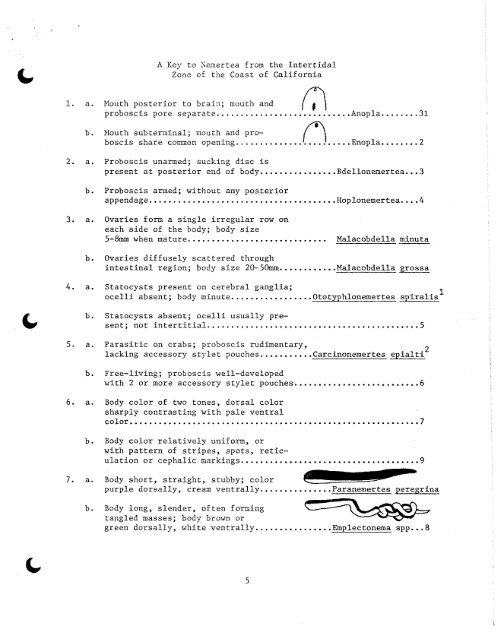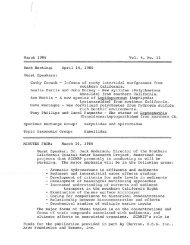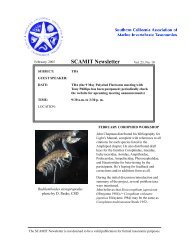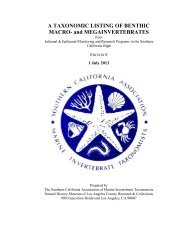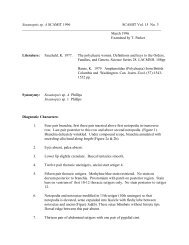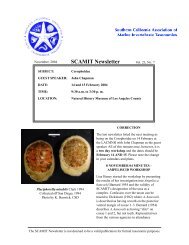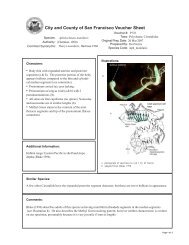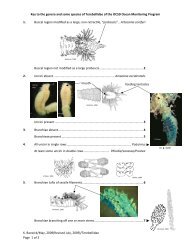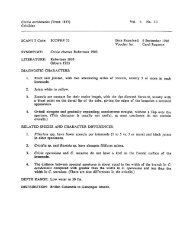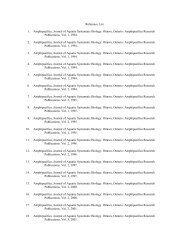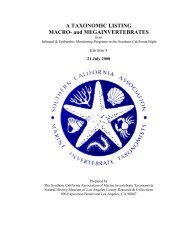You also want an ePaper? Increase the reach of your titles
YUMPU automatically turns print PDFs into web optimized ePapers that Google loves.
A Key <strong>to</strong> <strong>Nemertea</strong> from the Intertidal<br />
Zone of the Coast of California<br />
1. a. Mouth posterior <strong>to</strong> brain; mouth and j |<br />
proboscis pore separate ' Anopla 31<br />
b. Mouth subterminal; mouth and pro- / \<br />
boscis share common opening '.....' Enopla 2<br />
2. a. Proboscis unarmed; sucking disc is<br />
present at posterior end of body Bdellonemertea... 3<br />
b. Proboscis armed; without any posterior<br />
appendage .Hoplonemertea... .4<br />
3. a. Ovaries form a single irregular row on<br />
each side of the body; body size<br />
5-8mm when mature Malacobdella minuta<br />
b. Ovaries diffusely scattered through<br />
intestinal region; body size 20-50mm ..Malacobdella grossa<br />
4. a. Sta<strong>to</strong>cysts present on cerebral ganglia;<br />
ocelli absent; body minute O<strong>to</strong>typhlonemertes spiralis'<br />
b. Sta<strong>to</strong>cysts absent; ocelli usually present;<br />
not intertitial 5<br />
5. a. Parasitic on crabs; proboscis rudimentary, 2<br />
lacking accessory stylet pouches Carcinonemertes epialti<br />
b. Free-living; proboscis well-developed<br />
with 2 or more accessory stylet pouches 6<br />
6. a. Body color of two <strong>to</strong>nes, dorsal color<br />
sharply contrasting with pale ventral<br />
color 7<br />
b. Body color relatively uniform, or<br />
with pattern of stripes, spots, reticulation<br />
or cephalic markings 9<br />
7. a. Body short, straight, stubby; color<br />
purple dorsally, cream ventrally Paranemertes peregrina<br />
b. Body long, slender, often forming<br />
tangled masses; body brown or<br />
green dorsally, white ventrally Emplec<strong>to</strong>nema spp...8<br />
5
Dorsally green; ventrally cream, white<br />
or pale yellow-green Emplec<strong>to</strong>nema gracile<br />
Dorsally velvet-brown; ventrally<br />
cream or buff . Emplec<strong>to</strong>nema burgeri<br />
9. a. Body marked with distinct longitudinal<br />
stripes 10<br />
b. Body not striped, or stripes accompanied<br />
by other markings 13<br />
10. a. Dorsal surface with 2 dark stripes<br />
on a pale ground color 11<br />
b. Dorsal surface with 4 or 6 dark<br />
stripes .. ... . .12<br />
11. a. Stripes fade out posteriorly; ocelli<br />
not visible without dissection;<br />
intestinal region often rosy or<br />
purplish Nemer<strong>to</strong>psis gracilis<br />
b. Stripes distinct throughout body<br />
lenght; 4 large ocelli visible, forming<br />
a rectangle on dorsal surface of<br />
the head; intestinal region of same<br />
color as rest of body Tetrastemma bilineatum<br />
12. a. Dorsal surface with 4 stripes: 2<br />
dorsal and 2 lateral ....Tetrastemma quadrilineatum<br />
b. Dorsal surface with 6 stripes: 2<br />
mid-dorsal, 2 dorso-lateral and 2<br />
ventro-lateral Tetrastemma sexlineatum<br />
13. a. Dorsal surface reticulated, with<br />
brown rectangular markings and<br />
stripes on a cream or buff ground<br />
color Tetrastemma reticulatum<br />
b. Dorsal surface striped or spotted<br />
or uniform 14<br />
14. a. Head white or cream, sharply contrasting<br />
with body color; and<br />
bearing a dark cephalic marking;<br />
body color striped or uniform .....15<br />
6
. Head of same color as body; without<br />
cephalic markings; body<br />
spotted or uniform 16<br />
NOTE THREE CHOICES<br />
15. a. Body reddish-brown; head white<br />
or cream with 2 triangular dark<br />
spots on dorsal surface .Amphiporus bimaculatus<br />
b. Body reddish-brown; head white<br />
with a dark wreathlike marking<br />
on the dorsal surface Tetrastemma sing if er<br />
c. Body color varies; head white<br />
with a single dark spot on dorsal<br />
surface<br />
16. a. Body with pattern of conspicuous<br />
vox i eiy p u-rp u reU. y*\ varttKj VilmeaA\JiTVV<br />
varic+y pa\iic(am Varle-Vy ft<br />
Tetrastemma nigrifrons<br />
spots 17<br />
b. Body color uniform 18<br />
17. a. Brown mottling on dorsal surface<br />
only, may condense in<strong>to</strong> irregular<br />
lines; 2 pair of large ocelli Oerstedia dorsalis<br />
b. Brown mottling extends over ventral<br />
surface, though less thickly;<br />
ocelli small, numerous Amphiporus punctatulus<br />
18. a. Ocelli form an irregular row along<br />
lateral nerve cords, extending well<br />
behind brain; large, sickle-shaped X^w^rtT..-.<br />
rhabdites present in epithelium Zygonemertes spp..l9<br />
7
. Ocelli anterior <strong>to</strong> brain; rhabdites,<br />
if present, are small, rod-shaped 20<br />
3<br />
19. a. Body white or yellow Zygonemertes albida<br />
b. Body green, often with purplish<br />
caste Zygonemertes virescens'<br />
STEPS 20-30; Ocelli must be examined. This is best accomplished by dissection,<br />
or by staining and clearing of specimens. For the latter, be sure <strong>to</strong> note body<br />
color carefully.<br />
NOTE 3 CHOICES<br />
20. a. With 2 ocelli at anterior tip of<br />
head 21<br />
b. With 4 ocelli forming a rectangle<br />
on head 22<br />
intestinal region deep green; prefers<br />
b. Body short, stubby; color white;<br />
intestinal region deep green; prefers<br />
muddy habitats Paranemertes sp. A"<br />
NOTE THREE CHOICES<br />
22. a. Proboscis sheath limited <strong>to</strong> anterior<br />
1/3 of body; ocelli minute;<br />
body yellowish. Dichonemertes hartmanae<br />
b. Proboscis sheath extends.<strong>to</strong> posterior<br />
1/3 of body; ocelli large,<br />
irregular, with rootlike processes<br />
of pigment extending on all sides;<br />
body opaque white .Prosorhochmus albidus<br />
c. Proboscis sheath extends <strong>to</strong> posterior<br />
end of body; ocelli large,<br />
spherical; body gray-green Tetrastemma candidum<br />
23. a. Ocelli small, in 4 clusters of 2-3,<br />
one on each side of proboscis and<br />
anterior <strong>to</strong> each brain lobe; body<br />
white, intestinal region green.. Paranemertes californica
24. a,<br />
25. a.<br />
b,<br />
26. a.<br />
27. a.<br />
28. a,<br />
b.<br />
29. a,<br />
30. a<br />
Ocelli vary, 14 or more present in<br />
clusters, or 10-20 present in rous;<br />
body white, yellow, red or brown;<br />
intestinal region green only if body<br />
is red Amphiporus spp ...24<br />
Ocelli form a single row of 5-10 on<br />
each side of head, the anteriormost<br />
being largest; body yellow Amphiporus cruentatus<br />
Ocelli form irregular clusters; body<br />
white, yellow, red or brown... .<br />
Body white or pale yellow.<br />
Body red or brown.<br />
Ocelli number 60-250, depending<br />
on size of the worn; body x^hitish.<br />
25<br />
26<br />
28<br />
Amphiporus formidabills<br />
Ocelli number 50 or less; body white<br />
or yellow 27<br />
Ocelli number 30-50; proboscis with<br />
3 pouches of accessory stylets; body<br />
opaque white; epithelium with rodshaped,<br />
yellowish rhabdites .Amphiporus imparispinosus<br />
Ocelli number 14-50; proboscis w ith<br />
2 pouches of accessory stylets;<br />
body yellowish; epithelium without<br />
rhabdites<br />
Body red; ocelli number 8-40...,<br />
Body brown; ocelli number 40-70.<br />
•Amphiporus flavescens<br />
Ocelli number 20-40; 6-10 larger<br />
ocelli form 2 groups on each side<br />
of head .Amphiporus rubellus<br />
Ocelli number 8-16; ocelli form<br />
irregular clusters on each side of<br />
head .<br />
Body color dark reddish or purplish<br />
brown; head with an angular whitish<br />
spot on each side, and sometimes a<br />
whitish V-shaped marking; ocelli<br />
number 40-70; apr. 20 in an elongated<br />
cluster on each anterior margin<br />
and 8-15 in each whitish spot<br />
9<br />
29<br />
30<br />
.Amphiporus californicus<br />
Amphiporus angulatus
Body color brown, due <strong>to</strong> minute<br />
dots thickly scattered on flesh ground<br />
color; ocelli number apr. 50,<br />
forming an irregular cluster on each<br />
side of head Amphiporus fulvus<br />
31. a. Mouth immediately posterior <strong>to</strong><br />
brain 33<br />
b. Mouth far behind brain Procephalothrix spp 32<br />
32. a. Body contracts in snarled tangle;<br />
species prefers hard sand or clay ^<br />
fully exposed <strong>to</strong> surf Procephalothrix major<br />
b. Body contracts in spiral coil;<br />
species prefers protected sites ^<br />
under s<strong>to</strong>nes or in mud Procephalothrix spiralis<br />
33. a. With distinct longitudinal cephalic ^<br />
grooves 43<br />
b. Without cephalic grooves 34<br />
34. a. Body remarkably thick and massive;<br />
Head white, speckled; Body color<br />
of 2 varieties: a) buff speckled<br />
with brown, and with narrow dark<br />
rings; and b) purplish-brown speckled<br />
with white, and with narrow<br />
dark rings Euborlasia nigrocincta<br />
b. Body filiform or ribbon-like; body<br />
not spotted 35<br />
35. a. Head with white terminal border,<br />
and single dark spot on dorsal<br />
durface of head; body deep red Baseodiscus punnetti<br />
b. Head without white terminal border;<br />
cephalic spot absent or<br />
more than one present; body white,<br />
brown or red ..36<br />
36. a. Body with rings and/or stripes"^ 37<br />
b. Body without distinct markings 42<br />
37. a. Body with 1, occasionally 2. dark<br />
rings near head.<br />
10
NOTE THREE CHOICES<br />
38. a. Body red; sometimes rather mottled;<br />
band is black or brown; size: <strong>to</strong><br />
2m; lateral sense organs often ^<br />
conspicuous. Tubulanus polymorphus<br />
b. Body white; band is brick red;<br />
size: 10-25mm; lateral sense ^<br />
organs conspicuous Tubulanus pellucidus"<br />
c. Body white or translucent; band ^^Xr'Zt*<br />
is brown, faint; size: 50-100mm; ^<br />
lateral sense organs inconspicuous .Carinomella lactea<br />
39. a. Body yellow, rosy or greenish, with<br />
black markings: 3 longitudinal<br />
stripes and a series of narrow<br />
rings T.. Tubulanus frenatus<br />
b. Body red or brown with white<br />
markings 40<br />
40. a. Body red with white rings, and<br />
without stripes Tubulanus albocinctus<br />
b. Body brown x^ith white rings<br />
and stripes ..41<br />
NOTE THREE CHOICES<br />
41. a. With 3 white stripes: 1 mediodorsal,<br />
and 2 lateral Tubulanus capistratus<br />
b. With 4 white stripes: 2 dorsal<br />
and 2 lateral Tubulanus cingulatus<br />
c. With 5 or 6 xrfiite stripes: 1 mediodorsal,<br />
2 dorso-lateral, 2 ventrolateral,<br />
and 1 medioventral which<br />
may be indistinct Tubulanus sexlineatus<br />
42. a. Body x-jhite or yellowish; head — - ^<br />
rounded; caudal cirrus absent Carinoma mutabilis<br />
b. Body red or rosy; head long and<br />
pointed; caudal cirrus present ^<br />
(easily lost) Zygeupolia rub ens<br />
11
43. a. Body yellow, nearly covered with<br />
brown spots, sometimes elongated<br />
and arranged in irregular lines or<br />
rectangles; caudal cirrus present ' .Micrura" pardalis<br />
b.<br />
44. a.<br />
Body not spotted; caudal cirrus<br />
present or absent 44<br />
Body dark, with single white<br />
band across dorsal surface of head 45<br />
b. Body without markings, or<br />
markings otherwise 46.<br />
45. a. Body deep red; white band located<br />
just behind tip of head; tip with<br />
a small dark spot Micrura nigrirostris<br />
b. Body reddish-brown or purple;<br />
white band connects posterior ends<br />
of cephalic grooves; tip without a<br />
dark spot Lineus <strong>to</strong>rquatus<br />
46. a. Tip of head white, sharply separate<br />
from body color 47<br />
b. Tip of head not strikingly different<br />
from body color 52<br />
47. a. Body with series of narrow rings<br />
of contrasting color.<br />
"b. Body without rings.<br />
NOTE THREE CHOICES<br />
48. a. Body deep-brown, chestnut or slaty<br />
with narrow yellow rings and 7-15<br />
inconspicuous yellow stripes, of which<br />
the mid-dorsal is most defined, con-<br />
13<br />
necting diamond-shaped areas on rings... Lineus pictifrons<br />
b.<br />
Body brown or black, with narrow<br />
whitish bands throughout body Micrura wilsoni<br />
c. Ventrally white; dorsally red, deep<br />
orange or vermillion with narrow<br />
white rings throughout body Micrura verrilli<br />
12<br />
48<br />
.49
49. a. Tip of head white, extending <strong>to</strong> apr.<br />
3/4 length of cephalic grooves; body<br />
dark brown or reddish-brown Cerebratulus albifrons<br />
b. Tip of head white, extending <strong>to</strong> 1/4<br />
or less length of cephalic grooves;<br />
black, red or brown<br />
50. a. Body black or broxm; slender, ^<br />
rounded throughout Micrura wilsoni<br />
b. Body deep red; flattened posteriorly<br />
or ribbon-like 51<br />
51. a. Body slender, rounded anteriorly,<br />
somewhat flattened posteriorly;<br />
caudal cirrus absent; size = 10-15mm Lineus rubescens<br />
b. Body long and ribbon-like, with<br />
thin lateral margins; caudal cirrus<br />
present; size: <strong>to</strong> 2m Cerebratulus montgomeryi<br />
52. a. Body with striking longitudinal<br />
markings 53<br />
b. Body without distinct longitudinal<br />
markings 54<br />
53. a. Body dark brown with mediodorsal<br />
stripe of white or yellow, widening<br />
on head <strong>to</strong> form broad whitish<br />
marking Lineus bilineatus<br />
b. Body pale grey, with numerous<br />
fine, irregular, interrupted dark<br />
brown longitudinal lines.' Cerebratulus lineolatus<br />
54. a. Body filiform; caudal cirrus absent Lineus spp 55<br />
b. Body thick, becoming flattened or<br />
ribbonlike posteriorly; caudal cirrus<br />
present 57<br />
55. a. Body yellow, orange or buff; with<br />
3-7 irregular ocelli, of which the<br />
anterior-most are largest.... Lineus flavescens<br />
b. Body brownish-green, brown or<br />
reddish-brown; with a row of 4-8<br />
ocelli on each side of head 56<br />
13
56. a. Body contracts in spiral coil in<br />
preservation; with 20 or more fine ^^<br />
inconspicuous lighter rings Lineus vegetus<br />
b. Body contracts by shortening and<br />
thickening in preservation; without strings<br />
.Lineus ruber<br />
57. a. Body with sharp, thin margins; ribbonlike;<br />
cephalic grooves deep, extending<br />
more than 1/2 distance from sur- ^<br />
face of head <strong>to</strong> brain .Cerebratulus spp. .58<br />
b. Body with rounded margins; cephalic<br />
grooves shallow, extending less than<br />
1/2 distance from surface of head <strong>to</strong> ^<br />
brain Micrura spp 59<br />
58. a. With white or strikingly pale<br />
lateral margins; size = 50-100cm Cerebratulus marginatus<br />
b. With pale lateral margins;<br />
size = 10-15cm Cerebratulus californiensis<br />
59. a. Body salmon, grey, flesh or light ^g<br />
brown; ocelli absent Micrura alaskensis<br />
b. Body olive-brown, ocher or buff;<br />
6-12 or more small ocelli form an ^g<br />
irregular row on each side of head .Micrura olivaris<br />
14
FOOTNOTES<br />
1. O<strong>to</strong>typhlonemertes spiralis is the only species of the O<strong>to</strong>typhlonemertidae<br />
reported from the Pacific Coast. The original description (Coe, 1940) is<br />
inadequate, and no further work on the group has been done. Work on<br />
Brazilian O<strong>to</strong>typhlonemertidae (Correa, 1948) indicates that more than one<br />
species is usually present in a given area.<br />
2. Carcinonemertes epialti is the only species of this family reported from<br />
the Pacific Coast. Other areas, i.e. the Atlantic Ocean, have yielded<br />
new genera and new species when closely examined. It is very probable,<br />
then, that other Carcinonemertidae are present on the Pacific Coast.<br />
3. Zygonemertes albida, Z. thalassina and Z,. virescens appear <strong>to</strong> have intergrading<br />
characters. Z. albida, in particular, is probably a juvenile form<br />
of Z. virescens, which is white when young.<br />
4. The original description of Paranemertes californica (Coe, 1904) states<br />
that two ocelli are present at the anterior tip of the head, occasionally<br />
fragmented in<strong>to</strong> granules. Coe r s revision, 1940, states that four clusters<br />
of two or three ocelli are present, one on each side of the proboscis and<br />
one anterior <strong>to</strong> each brain lobe. Coe, 1944, also described a Gulf of Mexico<br />
species which has two ocelli at the anterior tip of the head. A complete<br />
redescription of ]?. californica and, possibly, a revision of the genus is<br />
necessary <strong>to</strong> clear up the confusion.<br />
5. Paranemertes sp. A refers <strong>to</strong> at least one, and possibly two or three, undescribed<br />
species present on the continental shelf in Southern California.<br />
It is characterized by the presence of two ocelli, and by certain peculiarities<br />
of the stylet and basis. The species appears <strong>to</strong> be quite separate<br />
from P. californica. f^utdojpo^daic^ ^ '<br />
6. The species of Amphiporus are very difficult <strong>to</strong> separate, as body color is<br />
not entirely reliable, and all other characters overlap tremendously. The<br />
group appears <strong>to</strong> be in a state of radiating speciation, and is probably<br />
best left as Amphiporus spp. by the non-specialist. The Amphiporus assemblage<br />
is unique <strong>to</strong> the Pacific Coast.<br />
7. I.D. confirmation for Amphiporus rubellus may be obtained by sectioning of<br />
the esophageal region. Beneath the esophagus proper, and the s<strong>to</strong>mach,<br />
ending blindly posteriorly, there is a highly developed esophageal caecum.<br />
The peculiarity exists only in A. bimaculatus and A. rubellus on the coast<br />
of California.<br />
8. In mature females of Amphiporus californicus, the olive green color of the<br />
ova shows through the body walls of the intestinal region in a very conspicuous<br />
fashion.<br />
15
(FOOTNOTES CONTINUED)<br />
9. Coe, 1940 moved Procephalothrix major and IP. spiralis from the genus<br />
Cephalothrix <strong>to</strong> the genus Procephalothrix without giving any justification<br />
for the change. The new combinations are accepted conditionally<br />
here.<br />
10. This couplet presumes that specimens have been fixed in formalin. In<br />
the family Tubulanidae, glandular cells in the epithelium change color<br />
on exposure <strong>to</strong> formalin, producing a characteristic "preservation ring".<br />
This preservation artefact is necessary <strong>to</strong> separate species of Tubulanus<br />
and Carinomella from species of Carinoma and Zygeupolia without sectioning.<br />
11. These three species are difficult <strong>to</strong> separate reliably. Tubulanus polymorphus<br />
T red color frequently fades <strong>to</strong> dirty yellow when preserved. The<br />
best approach is <strong>to</strong> look at a lot of specimens. T^ pellucidus is relatively<br />
uniform in appearance, and can be separated accurately with practice.<br />
Carinomella lactea can be separated from all Tubulanus spp by sectioning<br />
of the intestinal region. In Carinomella, the lateral nerve cords are<br />
imbedded in the longitudinal muscles posteriorly. In Tubulanus, the lateral<br />
nerve cords are external <strong>to</strong> the circular muscles throughout the body.<br />
12. These two species are placed in different orders. Carinoma mutabilis<br />
(Paleonemertea) may be separated from Zygeupolia rubens (Heteronemertea) by<br />
sectioning of the esophageal region. In this region, Carinoma spp. have 3<br />
muscular layers: an outer circular, a middle longitudinal, and an inner<br />
circular layer. Zygeupolia spp have 2 layers only: an outer circular and<br />
an inner longitudinal layer.<br />
13. The markings of Lineus pictifrons vary considerably according <strong>to</strong> its state<br />
of contraction and/or preservation. The "diamonds" connecting transverse<br />
and longitudinal markings are characteristic, unique, reliable, and visible<br />
even when all other markings are obscured.<br />
14. The white rings of Micrura wilsoni often fade with preservation.<br />
15. These species are difficult <strong>to</strong> separate. Lineus vegetus characteristically<br />
reproduces by fragmentation and regeration. Lineus ruber characteristically<br />
reproduces sexually. I,, vegetus generally prefers sites among growths and<br />
under s<strong>to</strong>nes in exposed surf zones. IJ. ruber prefers protected muddy sites<br />
under s<strong>to</strong>nes. Gontcharoff, 1951, has described an L. ruber complex of 4<br />
species from French waters. One of these species, _L. viridis, was synonymized<br />
with I,. ruber by Coe, 1940, but may be identical <strong>to</strong> _L. vegetus.<br />
Another, _L. sanguineus, has not been reported from California waters, but<br />
may have gone unrecognized, thus far.<br />
16. The genera Lineus, Micrura, and Cerebratulus are not adequately separated by<br />
definition. Cantell, 1975, has examined the problem, and concluded that<br />
Lineus is probably an artificial group containing several genera. He also<br />
16
(FOOTNOTES CONTINUED)<br />
states that adequate definition and separation of the three genera is<br />
not possible at this time, due <strong>to</strong> lack of sufficient ana<strong>to</strong>mical investigation.<br />
The most that can be said at this point is that most species of<br />
Cerebratulus have neurochord cells in the brain and nerve cords, while<br />
most species of Micrura do not.<br />
17. There is some doubt that both of these species are valid. The only consistent<br />
point of distinction appears <strong>to</strong> be relative size, not a reliable<br />
basis in naming species. Redescription of both species is indicated in<br />
order <strong>to</strong> determine whether Cerebratulus californiensis is valid or a juvenile<br />
and synonym of
REFERENCES<br />
Cantell, C.E. 1975. Ana<strong>to</strong>my, taxonomy and biology of some Scandinavian<br />
Heteronemertines of the genera Lineus, Micrura and Cerebratulus.<br />
Sarsia 5.8:89-122.<br />
Coe, W.R. 1905. <strong>Nemertea</strong>ns of the west and north-west coasts of North<br />
America. Bull. Mus. Comp. Zool. Harvard Coll. 47:1-319.<br />
Coe, W.R. 1940. Revision of the nemertean fauna of the Pacific Coast of<br />
North, Central and northern South America. Allen Hancock Pacific<br />
Exped. 2(13):247-323.<br />
Coe, W.R. 1943. Biology of the nemerteans of the Atlantic Coast of North<br />
America. Trans. Connect. Acad. Arts Sci. 35:129-328.<br />
Coe, W.R. 1944. A new species of Hoplonemertean (Paranemertes biocellatus)<br />
from the Gulf of Mexico. J. Wash. Acad. Sci 34(12):407-409.<br />
Correa, D.D. 1948. O<strong>to</strong>typhlonemertes from the Brazilian Coast. Comm. Zool.<br />
Mus. Hist. Nat. (Montevideo) 2(49):1-12.<br />
Friedrich, H.V. 1965. Gesamtverzeichnis der Literatur uber die Nemertinen.<br />
Veroff. Ubersee-Museum, Bremen 3(4):204-244.<br />
Gontcharoff, M. 1951. Biologie de la regeneration et la reproduction chez<br />
quelques Lineidae de France. Ann. Sci. Nat. Zool. II Ser. 13:149-235.<br />
Haderlie, E.C. 1975. Phylum <strong>Nemertea</strong> (Rhynchocoela). In Smith, R.I. and<br />
J.I. Carl<strong>to</strong>n (eds.): Light's Manual: Intertidal Invertebrates of the<br />
Central California Coast. Third Ed. University of California Press,<br />
pp. 112-120.<br />
Roe, P. 1976. Life his<strong>to</strong>ry and preda<strong>to</strong>r-prey interactions of the nemertean<br />
Paranemertes peregrina Coe. Biol. Bull. (Woodshole) 150(1):80-106.<br />
18


